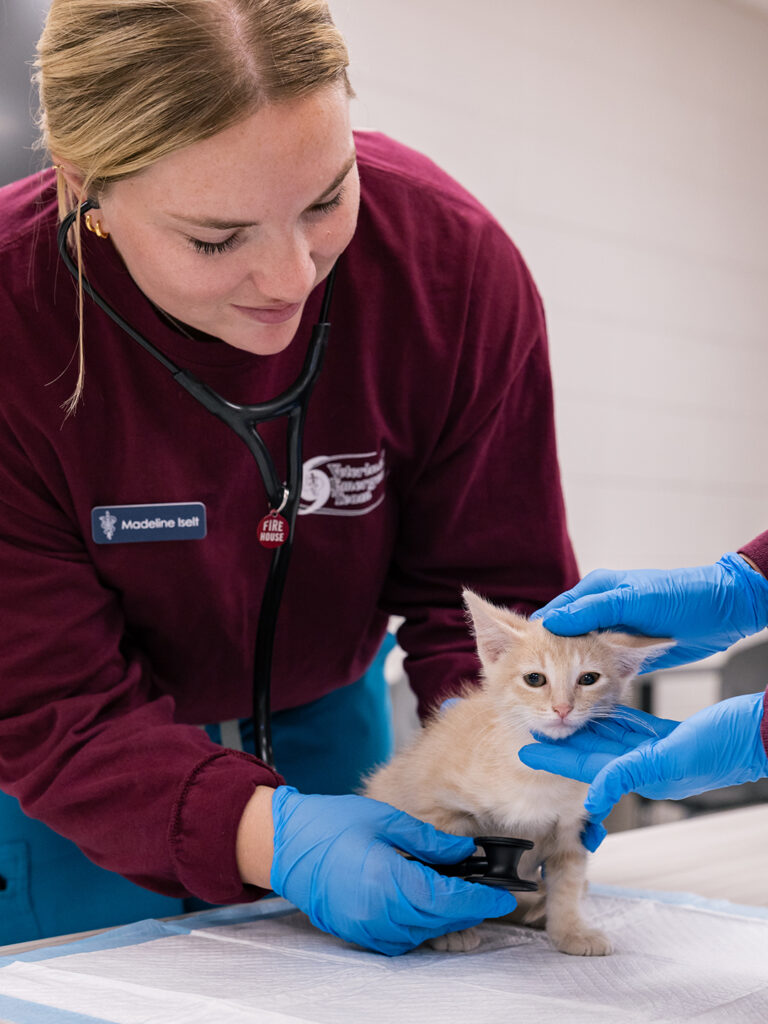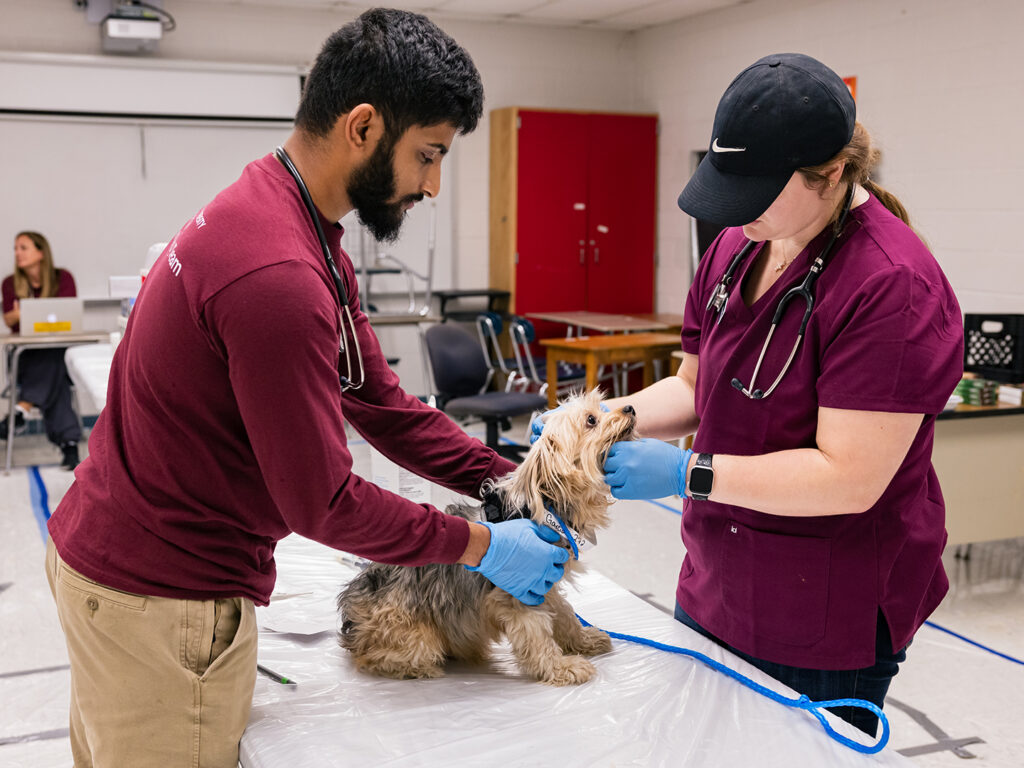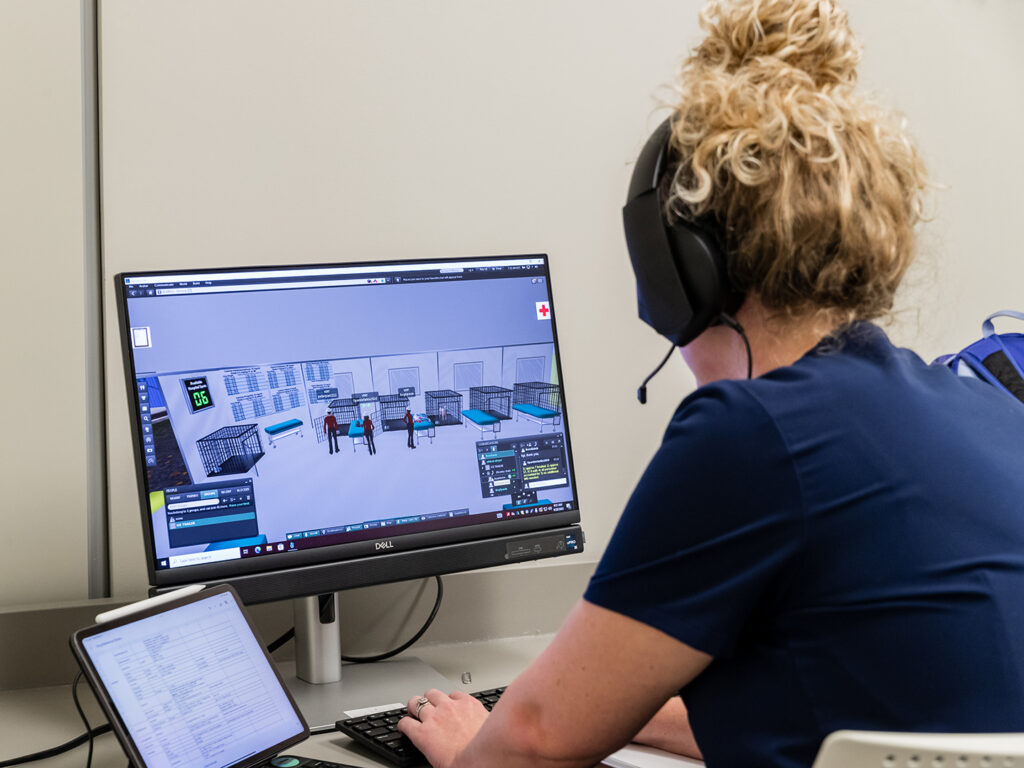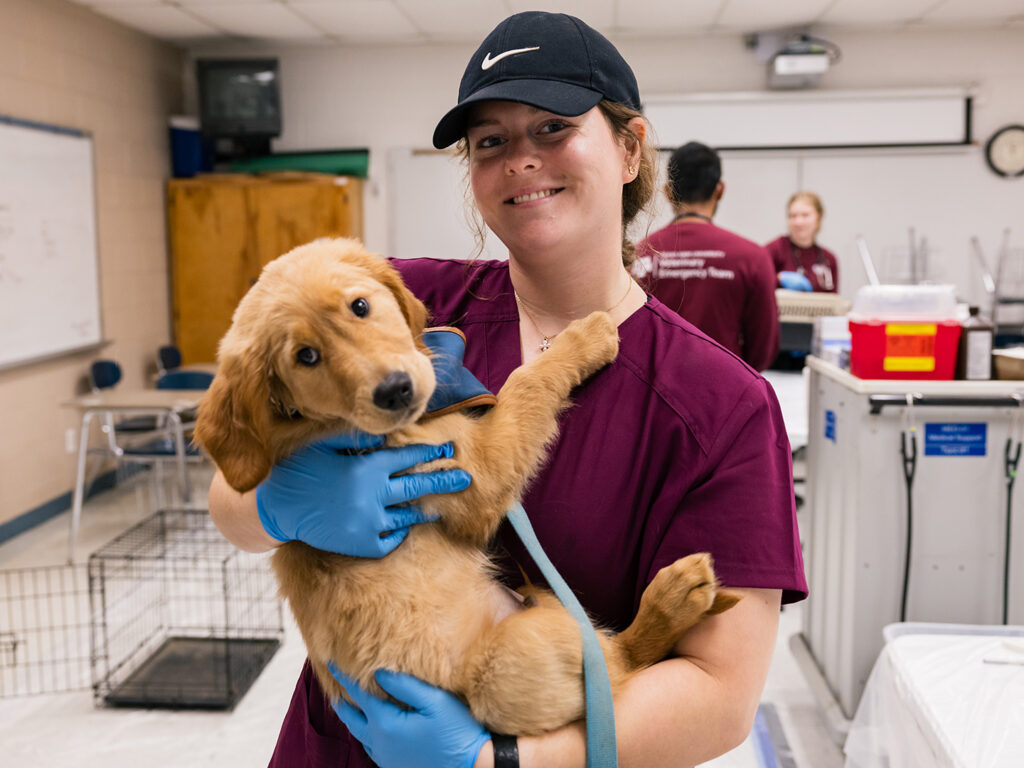Texas A&M Veterinary Emergency Team Shapes How Future Aggie Veterinarians Prepare For, Respond To Disasters
Story by Rachel Knight, VMBS Communications

Photo by Jason Nitsch ’14, Texas A&M University Division of Marketing and Communications
Disasters related to weather or climate are increasing in frequency and intensity, according to the United Nations. The increase in severe hurricanes, tornadoes, wildfires, landslides, and other disasters means more communities find themselves in the path of dangerous weather.
Community leaders, including veterinarians, are increasingly called upon to prepare for and respond to disasters, which is why the Texas A&M School of Veterinary Medicine & Biomedical Sciences’ (VMBS) curriculum includes a veterinary emergency preparedness rotation.
The rotation is led by faculty on the VMBS’ Veterinary Emergency Team (VET), which provides medical support to urban search-and-rescue teams and resident animals in response to natural and human-made disasters at the request of the Texas A&M Task Force or county jurisdictions.
The VET has deployed 19 times in Texas in response to disasters like the 2023 Perryton tornado, 2022 wildfires in Eastland, and Hurricane Harvey. The team has also deployed twice to California in response to wildfires and to Florida in response to Hurricane Ian.
Addressing A Growing Global Need
While caring for animals in the aftermath of disasters might seem like plenty to shoulder, faculty on the VET strive to do more by educating the next generation of veterinarians, who are more likely to serve a community affected by disasters during their veterinary career than previous generations.
VET director Dr. Debra “Deb” L. Zoran leads the VET’s rotation. A professor in the Department of Small Animal Clinical Sciences, she has been a veterinarian for Texas A&M Task Force 1 since 1997 and a deployable member and small animal lead on the VET during deployments since 2014.
Because the VET rotation teaches skills and lessons that are both timely and important, veterinary students from other countries also travel to Aggieland for the one-of-a-kind course. Dr. Melodie Ares Monast came to College Station in the spring of 2023 from Quebec, Canada, for the rotation.
“I came because we don’t have anything like this in Canada,” Ares Monast said. “We need training like this in Canada because we are experiencing an increase in floods but we don’t have any resources like the VET. Being a pioneer in this work is challenging but also rewarding. I know that I can take home what I learn and start implementing some of it in my own community.”
Preparing Future Leaders

Photo by Jason Nitsch ’14, Texas A&M University Division of Marketing and Communications
The two-week course kicks off with a week focused on disaster preparedness. Zoran teaches her students that preparedness starts with realistically assessing their own mental preparedness.
“If you don’t have your own personal ducks in a row, you cannot possibly tackle helping someone else,” Zoran said. “It starts individually with self-awareness of stress and resiliency. You have to have inner core health.”
Once the importance of inner core health has been instilled in her students, Zoran teaches them to conduct a basic preparedness and threat analysis spanning across their sphere of influence. She has them start with their family and then expand their scope to their practice, to their clients, and, finally, to the greater community in which they serve.
“The most common response to any disaster is denial,” Zoran explained. “Understanding risk doesn’t mean you’re scared; it means you are situationally aware. You protect yourself, your family, your practice, and your community by understanding the risks, the probability of those risks becoming a disaster, and what your plan is if the unthinkable happens and your community is in a full blown disaster.”
Rather than simply telling her students that preparedness is important, Zoran developed a curriculum that shows them the importance of disaster preparedness while also serving Texans. VET rotation students visit a Texas county, conduct a risk assessment for the county, and work with county leadership to develop a disaster plan in their first week on the rotation.
Dr. Julie Gonzalez, who participated in the VET rotation as a student, said the experience of developing a disaster plan for a community was invaluable and that she plans to implement a similar plan in the practice she joined in Houston.
“I’ve never really been in that situation,” Gonzalez said. ”In the future, especially living in Houston, where there are hurricanes and disasters regularly, knowing the veterinarian’s role in responding to a disaster and how I can get involved with my county ahead of time is really helpful. When I join the practice, I’m going to make sure we have a disaster plan.“
Dr. Anna Claire Huffman also participated in the VET rotation as a VMBS student and said she feels confident in her new skills to develop a disaster plan as well.
“As Dr. Zoran says, hope is not a plan,” Huffman shared. “In the VET rotation, we work on developing the skills we need to make a plan so that later on we can eventually provide help for people.
“The first week of the rotation got me thinking about the rural community I now serve in McLennan County,“ she said. “Thanks to Dr. Zoran and the VET rotation, I’m prepared to start introducing myself and my ideas about disaster planning to community leaders when I join the practice.”
Responding To Disasters

Photo by Jason Nitsch ’14, Texas A&M University Division of Marketing and Communications
After walking students through how to think ahead and plan for disasters during week one of the rotation, students spend week two practicing disaster response.
“The second week brings everything full circle and really helps connect the dots,” Zoran explained. “It helps the students see the value of the plan they spent week one building. They suddenly realize that if they didn’t have a plan, it would be absolute chaos trying to respond during an emergency or disaster.”
Zoran said she teaches her students to approach disaster medicine as if they’re operating a mobile army surgical hospital. She reminds her students that disaster medicine is often basic medicine conducted out in the field — the goal is to prepare the patient for transportation to a medical facility better equipped to meet their medical needs.
“It’s something they’ve never experienced,” she said. “So not only is it hard, but we force them to make triage and medical decisions in a disaster situation on their own.”
The VET rotation includes a virtually simulated disaster that the students are required to respond to as if they are the veterinarians serving the affected community. Zoran explained that the virtual program used in the simulation, known as Second Life, gives students hands-on experience that they don’t get in traditional veterinary medicine learning environments such as the classroom or teaching hospital.
“When they do rotations at the teaching hospital or complete an externship with a veterinary clinic, they still have someone either in the room or just outside the room with whom they can consult for a second opinion. That’s not always the case in a disaster,” Zoran explained.
“The Second Life exercise is also valuable because it forces them to work in a simulated state of chaos. If I were to give them the cases we work in Second Life on a piece of paper in a quiet room, they’d all know exactly what to do, but in a disaster you don’t have a quiet room. You’ve got the mayor talking in your ear, the safety officer talking to you over a radio, the person behind you is looking for their animal and coming to you for help, and all you want to do is get back to the case you’re working on. It’s important for students to experience that environment so that they know how it can affect their ability to think and make decisions.”
When disaster strikes, students who are in the VET rotation deploy with the team and can put their new skills to use in real time.
Prepared Veterinarians Respond To Disasters

Photo by Jason Nitsch ’14, Texas A&M University Division of Marketing and Communications
Zoran said she knows that the VET rotation is helpful because of the feedback she receives from former students.
“A few of my former students live in Colorado, and two of them called me a few years ago when the wildfires were engulfing Aurora,” Zoran said. “I remember that one of our former students living in the area was helping evacuate some horses and called to thank me for the preparation that the VET rotation gave them for that experience.
“Another former student from the East Coast called me when a hurricane hit there. They were running an evacuation shelter and said the rotation helped them prepare for and then respond to the disaster.”
Dr. Jayton Bailey, a 2015 DVM graduate who took the two-week rotation as a student, was practicing in Eastland County when wildfires engulfed the southeast part of the county in 2022.
“The VET rotation prepared me for the experience,” said Bailey, who is also on the Texas Veterinary Medical Foundation Board of Trustees. “I’d saved my personal preparedness plan and updated it every year. I pulled it out when the fires began. Thinking of the situations I encountered in the rotation really helped me, too. When my clinic got a call from the VET saying that they were headed our way to help, I was so thankful. It was really cool to work with the people who helped train me to respond to the disaster and to see them in action in my own backyard.”
###
Note: This story originally appeared in the Fall 2023 issue of VMBS Today.
For more information about the Texas A&M School of Veterinary Medicine & Biomedical Sciences, please visit our website at vetmed.tamu.edu or join us on Facebook, Instagram, and Twitter.
Contact Information: Jennifer Gauntt, Director of VMBS Communications, Texas A&M School of Veterinary Medicine & Biomedical Sciences; jgauntt@cvm.tamu.edu; 979-862-4216


